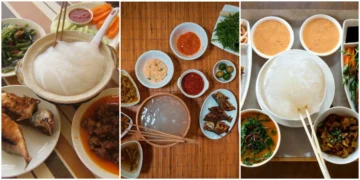Cambodia, known for its ancient temples, lush landscapes, and diverse cultural fabric is also revered for its unique cuisine that blends indigenous flavors with influences from neighboring regions. Of the many treasured dishes of the Southeast Asian nation Cambodian Cuisine is best represented by Fish Amok (the best food of Cambodia). It is an aromatic curry that has come to represent Cambodian identity and is commonly known by its Khmer name of Amok Trey. Fish Amok serves not just as a meal; rather it is an experience that captures the spirit, history, and communal warmth of Cambodia!
Why is Fish Amok the Best Food of Cambodia?

Fish Amok has quickly earned Cambodians’ praise as one of its finest dishes for its unique combination of textures, flavors, and cultural significance. This iconic Cambodian cuisine is distinguished by a creamy coconut milk base infused with fragrant pastes of spices and herbs to provide an exquisite flavor profile; tender fish from local freshwater rivers then absorb this aromatic sauce for an experience both hearty and refined.
Fish Amok stands out not only with its delicious taste but also with how it brings generations together. Fish Amok has long been prepared in celebrations and family gatherings; sharing this sumptuous curry served in banana leaf cups reinforces a sense of belonging in a country where traditions are valued and passed down from one generation to the next.
Ingredients of Fish Amok
Fish Amok’s secret lies in its carefully chosen, high-quality ingredients; each adds something different to its unique profile:
- Fresh Fish: When selecting freshwater fish for consumption, white-fleshed species like snakehead or tilapia tend to be most appropriate. When cutting into chunks for cooking purposes, ensure that each bite stays soft after it has been prepared.
- Coconut Milk: As the heart and soul of this dish, coconut milk serves as an indispensable foundation that counteracts spicy heat while adding subtle sweetness.
- Fish Amok Paste: At the heart of Fish Amok lies its paste, traditionally composed of lemongrass, kaffir lime leaves, galangal, turmeric, garlic, shallots, and red chili peppers pounded together until smooth using an age-old mortar and pestle method to preserve flavors intact.
- Eggs: Lightly beaten eggs may be added to the mixture for a custard-like consistency that helps bind all the ingredients together.
- Herbs and Spices: In addition to amok paste, other ingredients like basil or dill may be added for an invigorating herbal note that elevates your dish.
- Banana Leaves: Although not an actual ingredient of this sauce, banana leaves have long been used as molds for steaming the curry, giving it an earthy scent while also creating an appealing visual presentation.
Prepare Fish Amok (Best Food of Cambodia)

- Making Amok Paste: The Amok Paste process begins by selecting and cleaning fresh herbs and spices. Lemongrass, kaffir lime leaves, galangal, turmeric, garlic cloves, and shallots are then traditionally combined using the traditional mortar-and-pestle technique until fragrant paste forms, both releasing essential oils while retaining authentic flavors.
- Marinating Fish: Cut fish into chunks and lightly marinate them with some of the prepared amok paste for 10-20 minutes to begin infusing each bite with its aromas. This step ensures that every tasteful bite contains aromatic notes from its aromatic blend.
- Preparing Coconut Sauce: In a wide, heavy-bottomed pan, gently simmer coconut milk over low heat before the remaining amok paste is gradually mixed. Lightly beaten eggs may also be added at this point to bind and thicken the sauce. Finally, this concoction should simmer over low heat until thickening slightly before being transferred back onto low heat. This helps the spices to meld seamlessly together for maximum flavor!
- Steaming in Banana Leaf Cups: After carefully mixing fish and sauce, they are spooned into small banana leaf cups. It serves both as a serving vessel and adds an additional fragrance note to the dish. Arranged into a steamer, these cups will remain there until their contents have cooked thoroughly. It typically takes 20 to 30 minutes depending on the size of the cup used.
What Makes Fish Amok Distinct?
Fish Amok stands out for many reasons. Its flavor profile strikes an appealing balance between rich coconut milk and tart. And, slightly tangy amok paste notes complement each other perfectly. It creates a dish with depth yet accessibility for a wide range of palettes. In contrast with many curries that rely heavily on cream or excessive spices, Fish Amok celebrates simplicity and freshness.
Fish Amok is a beloved comfort food that’s served interactively. Traditionally in individual portions served on banana leaf cups for maximum interaction and a communal dining experience. This method also highlights nature and connection. Banana leaves themselves contribute aroma and presentation elements of this traditional Filipino dish. Fish Amok makes an elegant treat both at meal times and at special events.
History of Fish Amok (Best Food of Cambodia)

Fish Amok’s roots lie deeply within Cambodia’s culinary history. It is said to have been inspired by both native Khmer traditions and Southeast Asian spices. Fish Amok has evolved over centuries to become what we recognize today. Once enjoyed only by royal courts and royal households alike, Fish Amok eventually found its way into everyday meals. Steaming in banana leaves honors ancient cooking techniques that value flavor preservation while being resourceful.
Fish Amok, an iconic Cambodian dish, remains a constant amid times of hardship and change. It serves as a symbol of resilience, creativity, and the unfaltering spirit of its people. Today it’s enjoyed both at home and upscale restaurants alike where chefs recreate classic recipes while staying true to tradition.
Other Authentic Dishes of Cambodia
- Bai Sach Chrouk: Tender marinated pork served over rice is a classic street food dish in Cambodia.
- Lk Lak: Stir-fried beef with a tart lime and pepper dipping sauce is often enjoyed alongside vegetables and rice dishes.
- Nom Banh Chok: A traditional Khmer noodle soup commonly eaten for breakfast that features fragrant fish gravy and fresh herbs.
- Khmer Red Curry: This milder version of Thai red curry boasts coconut milk, potatoes, meat, or fish options.
- Sticky Rice and Mango: Sticky rice combined with fresh mango slices is a refreshing dessert from Cambodia.
Each dish here provides a glimpse into Cambodia’s diverse culinary tradition. It underscores food doesn’t only provide sustenance but is also important in maintaining cultural identity and history.










Discussion about this post